
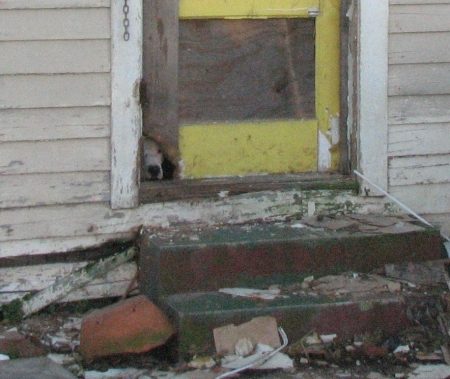
Officers help dogs living in dismal conditions
I’ve got another illuminating update from the field filed by webmaster Shelly Patton of the Louisiana SPCA. She’s been riding along with animal control again.
Her story struck me hard. I felt like I was riding along with her. But what resonated most was the importance of citizen involvement. Filing a report when you witness animal neglect or cruelty can change an animal’s destiny.
Sometimes taking action involves a bit of legwork. Animal control for a particular region might be handled by the city, or contracted to an independent agency such as an animal welfare organization. If at first you don’t track down the organization with proper authority, don’t give up. Ask around. Over the years, I’ve reported many people in a multitude of cities. The results were satisfying.
As you’ll find out when you read Shelly’s story, a few telephone calls on your part can make a dramatic difference to an animal’s treatment. We owe it to the animals to speak out and get involved. If we don’t, who will?
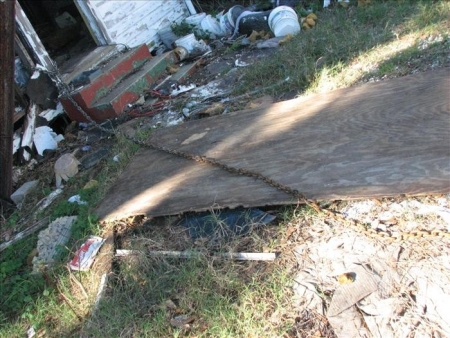
Here’s what Shelly reported:
Officers Travis Causey and Melanie Fenwick had been at the address the previous day responding to a “roaming at large” call. The first thing they noticed when they arrived was a pit bull puppy in the cab of a blue pick-up truck. The puppy was excited by our arrival. Jumping at the window, he was clawing to get out and greet them.
Walking past the truck, they climbed the weather worn stairs and knocked on the door. They surveyed the yard below. Debris was everywhere. The yard had the junkyard appearance so common in low-income areas.
Just past the driveway sat the pickup truck nestled in overgrown vegetation. The truck was waiting for “someday” to arrive. Its hood was opened in a silent scream. The passenger window was hanging precariously in its frame. The back right tire was deflated and the truck bed was filled with debris. At this point, it was nothing more than a kennel. A dangerous kennel.
Hearing the door open behind them, Melanie and Travis turned and told the man answering that they were there responding to a complaint. They asked if he had seen any strays roaming. “No. No dogs,” he said. “The only dogs I seen are mine. I have them out back. Want to see them?” He spoke of his dogs with a sense of pride. He didn’t think he was doing anything wrong.
As the man walked them around to the back, he was questioned about the puppy in the truck cab.
The backyard was worse than the front: overgrown, littered with empty bags of dog food, dirty cracked buckets, cans scattered about, broken furniture, discarded piles of plywood, and trash.
A dilapidated shed stood to the right. It had no doors or windows. Even sections of the exterior walls were missing. The inside was falling apart, just a framework with crumbled sheetrock hanging here and there. Years of dust and grime held it together. The floor was a build-up of paper, sheetrock, 2x4s, and filth. This shed was home to a white female pit bull. The 10-foot chain securing her to the doorframe was G80, a large, heavy tow chain. Perhaps at one point the chain had belonged to the truck out front. Now it was dead weight around the dog’s neck.
Beyond the first shed sat a second. This shed had a door and tightly boarded windows. The only light filtering into this enclosure came through a hole in the bottom left corner of the door. It was just large enough for the muzzle and eyes of a large dog to fit through. The officers were being watched.
Melanie and Travis began to educate the man about city ordinances concerning dogs and basic standards of animal care. He was in violation of many of them.
They explained to the man exactly what laws he had violated, and the consequences he would face if he didn’t raise the standard of care for his dogs. They informed him that an officer would return to verify that he had made the changes necessary to comply.
Some situations require the animal be removed from the property immediately. But that wasn’t the case on this call. Ninety percent of the complaints animal control officers respond to require only education and condition checks. Many people don’t know they are doing the animal an injustice by the way they are keeping them. When the animal’s needs are outlined, they often make changes willingly that are in the best interests of the animal.
Primarily, animal control officers are community educators. They speak for the voiceless, advocating for them to people who love their animals but just don’t know any better.
Melanie and Travis had scheduled this man’s condition check for a few days later, but when time allowed for the visit the next day, the officers didn’t hesitate to arrive earlier than scheduled. Particularly because of the puppy and chained dog involved.
We walked around back to have a look.
The white pit bull – now unchained – was watching us through the hole in the door. The man enthusiastically told us the cab puppy was now in the house. Two major issues had been resolved.
The man opened the shed door so the officers could get a better look at the dogs and the conditions inside the shed. Out ran the white pit bull. Accompanying her was a blue male. Both were a bit on the thin side, but by no means emaciated.
The man told us he let them out at least once a day to run around. Judging by the way they stayed in the area, I believed him.
At one point, the female ran by, kicking up a kitchen knife lying in the weeds near a pile of wood. As the metal flashed in the sun, it caught Melanie’s eye and offered her the perfect opening for explaining the importance of removing all debris from the immediate area. She set parameters for the clean up, emphasizing the dangers that debris posed to the paws of a running dog.
Travis and I went into the shed. Although it was dark, the darkness was not a violation of city code. Travis noted that there were two bowls of clean water and two empty food bowls. There was only a small amount of fecal matter on the floor, an indication that the man did clean up after his dogs.
But the smell was a problem. The air was thick with ammonia. Travis patiently explained something needed to be done about the buildup of urine on the floor. Cleaning the floor using a mild bleach solution once a week should do it. Travis told the man, “You want to take as good a care of your dogs as you do your children.” To me, it appeared that his statement sparked a dawning enlightenment in the man. Travis had given him a visual he could understand.
The focus turned to the condition of the dogs themselves. “Feed them a little more. They are too thin,” Travis added, pointing out a few obvious medical conditions that needed addressing. The female had a bloody tail tip. The male had a minor skin condition, and possibly an ear infection.
After running through the list of requirements the man had to complete and sustain, including yard clean-up and a veterinary visit, another condition check was scheduled. Officers will return in two weeks to verify compliance.
What struck me about this experience was the man’s willingness to do right by his dogs. He had already made some of the necessary changes he had learned about the day before. I got the impression that he cared. He just hadn’t known any better.
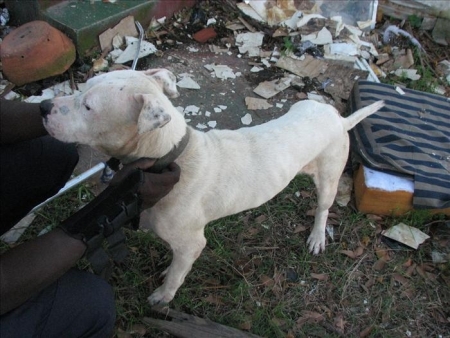
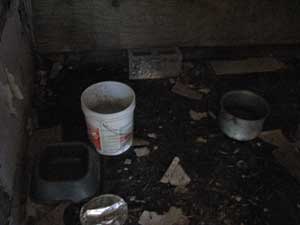
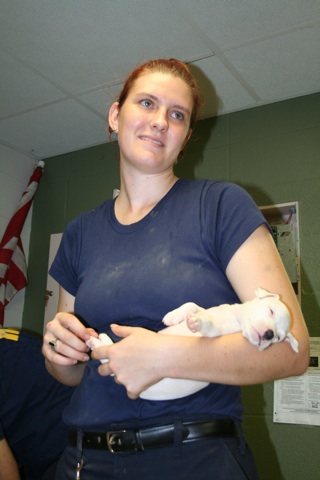
Louisiana SPCA animal control officer Melanie Fenwick cuddles a pit bull puppy. I snapped this photo of her at a temporary shelter set up by LA SPCA in Baton Rouge. I fled the city with staff and the shelter animals this past September when Hurricane Gustav rolled in.
Join the newsletter and never miss out on dog content again!
"*" indicates required fields
By clicking the arrow, you agree to our web Terms of Use and Privacy & Cookie Policy. Easy unsubscribe links are provided in every email.